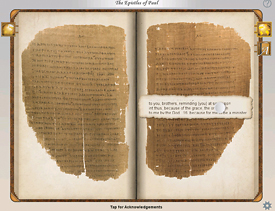More online
• Download the free app for an iPhone or iPad, search for “PictureIt: EP” at iTunes >
• Learn more about the Pauline Epistles >
• View photos of the Michigan leaves in the Advanced Papyrological Information System database. Select APIS, then Search APIS, and enter 6238 in the search field >
• Watch a video preview of the app >
The U-M Library’s most famous papyrus, known to scholars as Papyrus 46 or P46, now is widely available in the form of an app for iPhone and iPad.
Users of “PictureIt: EP” can flip through high-resolution images of the third-century codex — the oldest known copy of the Letters of St. Paul — as they would through pages of a book.
“This gives an idea of what it was like to read an ancient book, with no capitals, no spaces between words, and no punctuation,” explains Arthur Verhoogt, acting archivist of the library’s papyrology collection.

The app reveals a translation from the Greek into English with a touch of a finger, either word-by-word or by the page. Readily accessible annotations explain where the papyrus differs from the Standard Version that people may know from the New Testament. They also point out scribal errors, which were common in an era when books were copied entirely by hand.
The codex in its entirety was originally made up of 104 pages — known as leaves — of which 86 survive. The university purchased 30 leaves in the 1930s from antiquities dealers in Egypt. The remaining 56 leaves (which are not included in the app) reside in the Chester Beatty Library in Dublin, Ireland.
“A general audience wants to touch this text. It’s important to them,” Verhoogt says. Images of the leaves can be viewed online, but the presentation of P46 as an electronic codex, accompanied by the translation and annotations, provides a richer experience of the material, particularly for the non-scholar.
The app was made possibly with the support of the Gardner and Ann Parsons Papyrology fund, and was built by Eric Maslowski, manager of the Digital Media Commons 3-D Lab, along with Sean Petty, graphics engine programmer, and Stephanie O’Malley, 3-D artist. Edgar Ebojo of the University of Birmingham prepared the translation.

